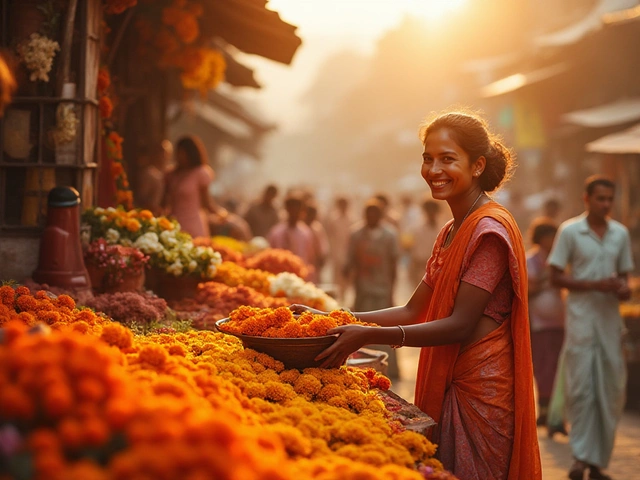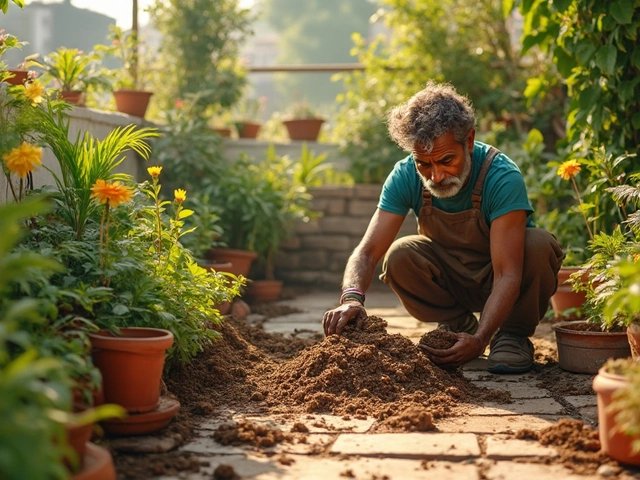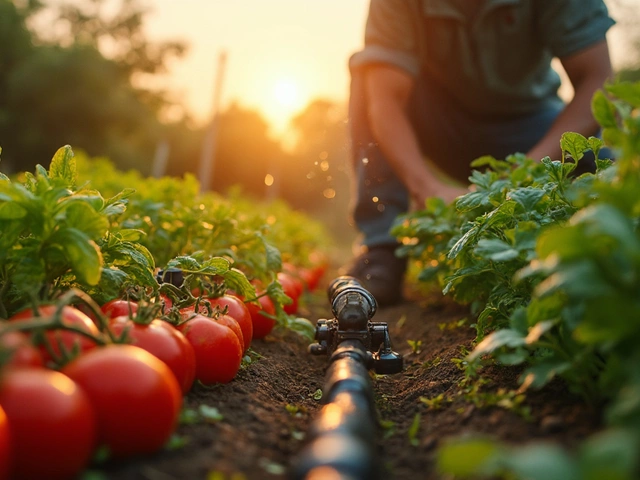Ever wondered what plant pops into most people’s heads when they hear “India”? If you ask around, you might think of tea, spices, or maybe even bright marigolds seen in Indian festivals. But one plant consistently stands out above the rest — Camellia sinensis, the mighty tea plant. Let’s get real, India and chai are almost inseparable. Yet, the story goes way deeper than steamy cups. From famous spices that lured explorers across continents, to sandalwood scenting temples, and sacred plants woven into tradition, India's botanical identity is rooted in so much more than just what you drink. Take a seat (or pour yourself a cup), this is a journey through India’s plant fame you probably never got in school.
The Crown Jewel: India’s Legendary Tea Plant
Start with tea, the ultimate Indian beverage. It’s impossible to walk a street, jump on a train, or visit a family and not see at least one person clutching a cup of chai. That famous drink, which billions love today, comes from the famous Indian plant Camellia sinensis. But here’s a twist — the tea plant didn’t even start out big in India. The British, obsessed with matching China’s tea game in the 19th century, found that wild tea actually existed in Assam. Once the secret was out, India’s landscape exploded with lush tea gardens stretching over rolling hills in Assam, Darjeeling, and Nilgiri. Today, the country produces more than 1.3 million metric tons of tea each year, ranking second only to China.
Indian tea isn’t just any tea. Assam tea hits you with malty power, Darjeeling tea is so delicate and aromatic it’s called the “champagne of teas.” Nilgiri teas add their own floral flavor. It’s not just exports either. Almost every Indian household boils fresh tea leaves, milk, ginger, spices, and sugar into that signature, comforting brew called chai. In India, tea isn’t a drink—it’s practically a lifestyle.
You might love the caffeine kick, but did you know the tea plant thrives best at between 1,000 and 2,000 meters above sea level? Indian tea estates are high up in the misty mountains, shaded by rows of silver oaks. The unique soil, climate, and even the way leaves are picked by hand influence flavor. Some estates, like Makaibari in Darjeeling, have been organic for generations.
Want to spot the difference between top Indian teas? Look for the Second Flush of Darjeeling (harvested in May-June), which sells for eye-watering prices at auction. Assam’s monsoon harvest pumps out those bold flavors perfect for cutting morning sleepiness. And while millions drink packaged black tea daily, premium loose leaves still get snatched up by connoisseurs around the world. The next time you sip a cup, remember—it literally fuels everything from monsoon moods to marathon conversations in India.
| Region | Main Variety | Flavor Profile | Annual Production (metric tons) |
|---|---|---|---|
| Assam | Camellia sinensis assamica | Malty, bold | 630,000 |
| Darjeeling | Camellia sinensis sinensis | Muscatel, floral | 8,000 |
| Nilgiri | Camellia sinensis | Bright, aromatic | 95,000 |
Spices: The Plants That Changed the World
If tea didn’t make India famous, its spices definitely did. Pepper, cardamom, cinnamon, turmeric, and cloves — the list reads like a masterclass in flavor, and every single one comes from a unique plant. Long before tea ever hit anyone’s lips, Indian spices ruled the world. Traders braved oceans, deserts, and rival kings just to taste a sprinkle of Indian black pepper (Piper nigrum). Here’s a mind-blowing fact: at one point, pepper was so valuable in Europe they called it “black gold,” and it was traded ounce-for-ounce against gold itself!
Let’s break down a few of the all-stars. Cardamom (Elettaria cardamomum) grows as a pod tucked deep in the thick forests of the Western Ghats. Its complex flavor—sweet, spicy, and a little minty—has made it the queen of Indian desserts and curries, plus a vital part of masala chai. The bold yellow of turmeric (Curcuma longa) isn’t just for looks. This root packs powerful antioxidants, and it’s landed in everything from food to face creams to trendy Western lattes. No Indian kitchen goes without it. Cinnamon (Cinnamomum verum) and cloves (Syzygium aromaticum) give biryanis, meat dishes, and even desserts their character. And then there’s chili — a plant that arrived from the Americas but became so Indian, no one can cook without it now.
Spices are more than just taste. They’re medicine, tradition, even currency. Ayurveda, India’s age-old wellness system, leans on plants like ginger, black pepper, and ajwain for remedies. Spices drive the monsoon markets in Kerala. Even ancient tax records track the value and routes of spice shipments—spices literally built fortunes and sultanates.
Want to grow a tiny Indian spice garden at home? Start with turmeric (just buy a fresh rhizome and bury it in warm soil), cardamom if your climate is humid, and for an easy win, cilantro for those Indian chutneys. Here’s a tip: keep them in a sunny spot but shaded from the hottest afternoon sun, and water regularly. Spice plants thrive in rich, well-draining soil—just like they do on India’s lush coasts and misty hills.
Sandalwood: The Fragrant Gold of the Subcontinent
Nothing smells quite like Indian sandalwood. If you’ve ever walked through an Indian temple, opened a wedding gift box, or sniffed fancy perfumes, you’ve probably experienced this legendary scent. Sandalwood (Santalum album) is native to southern India, especially in Karnataka and Tamil Nadu, where the government tightly controls its harvest because the tree is so precious. What makes it so valuable? It’s not the wood itself; it’s the fragrant, creamy oil harvested from the tree’s core that fetches the big bucks. This “liquid gold” perfumes incense, soaps, oils, and countless religious ceremonies.
Sandalwood’s story is not just about commerce, but also culture. The wood is sacred in Hindu and Buddhist rituals, carved into deity idols, or ground into paste for marking foreheads in prayer. In ancient Indian texts, kings smeared sandal paste to cool their skin in the country’s broiling summers. No wonder thieves pilfered whole forests just to sell the stuff overseas. These days, India protects sandalwood fiercely—every tree belongs to the state until it’s legally harvested.
Here’s something cool — sandalwood trees grow by “borrowing” from neighbors. They’re semi-parasitic, plugging their roots into nearby trees for extra nutrients. Getting a sandalwood tree started in your own backyard? Not easy. You’ll need to plant it near hosts like pigeon pea or Casuarina to keep it healthy. And be patient; sandalwood grows slowly, only reaching commercial maturity after about 15 years.
Sacred and Symbolic Plants: Banyan, Lotus, and Tulsi
India’s plant fame isn’t just about products or exports. Some plants are icons because they hold deep cultural, spiritual, and even political meaning. The Banyan tree (Ficus benghalensis) is India’s national tree and is famous for its mind-blowing roots, which drop from the branches and form whole forests from one tree. These giants provide shade, shelter, and community gathering spaces. Legend says monks meditated under banyans to find enlightenment. Ask anyone in a rural Indian village, and they’ll probably tell you “Meet me under the banyan.”
Then there’s the lotus (Nelumbo nucifera), India’s national flower, which grows in muddy ponds but blooms fresh and bright—a symbol of purity rising above chaos in Hindu and Buddhist lore. Every temple pond across India brims with bright pink and white lotuses. The plant’s seeds and roots find their way into snacks, too, like the crunchy “makhana.”
Can’t forget tulsi, or holy basil (Ocimum tenuiflorum). Walk into any traditional Indian home, and you’ll spot a tulsi plant in the courtyard, often on a raised brick platform. Considered a goddess in leaf form, tulsi is used in daily prayers, herbal teas, and traditional medicine. Ayurveda swears by it for coughs, colds, and reducing stress. It’s tough, too — tulsi can grow in regular pots on a sunny windowsill, as long as you water it well.
Symbolic plants are everywhere in Indian rituals: mango leaves strung as doorway garlands for good luck, neem leaves chewed for health, and peepal trees protected by sacred threads. These plants are so woven into daily life, sometimes people forget they came from the wild in the first place.
A Glimpse Beyond: New Trends and Endangered Treasures
So what about the future? Indian agriculture and plant fame aren’t stuck in history. These days, there’s huge buzz around organic farming, heirloom seed saving, and protecting rare native plants like the endangered Indian sandalwood, Himalayan blue poppy, or rare orchids found in the northeast. Plant conservation groups and backyard hobbyists have taken up the mission to rescue, replant, and cherish old varieties almost lost to big agriculture. Social media is full of Indian gardeners swapping seeds for rare curry leaf plants, or explaining how to grow ginger in plastic bottles. Even big old estates are turning towards eco-friendly permaculture models, which blend ancient wisdom with new science.
One under-the-radar trend? Growing forgotten “millets” like finger millet, pearl millet, and foxtail millet. These ancient grains are climate-smart, drought-resistant, and super nutritious — a reason they’re making a comeback from dusty recipe books back into everyday Indian meals. Chefs now put them in fancy restaurant menus, while rural families never stopped making earthy rotis and porridges with them.
Of course, some plants that once made India globally famous are threatened by overharvesting, habitat loss, or just plain neglect. The world’s appetite for sandalwood nearly drove it to extinction before laws stepped in. Native forest trees, wild fruits, and untamed medicinal plants need love too. Moves like seed banks, community farming, and stricter legal protection offer hope. Planting native species in your home garden isn’t just a trend — it’s a quiet act of conservation anyone can try, whether you’re in Mumbai or Minnesota.
End of the day, “Which plant is India famous for?” doesn’t have a single answer. Tea may take the top spot, but India’s real fame is in the endless variety of plants — each with its own story, spirit, and legacy. Next time you sip chai, taste a curry, or stand under a sprawling banyan, you’re sharing in a living tradition that’s as much about roots as it is about leaves. That’s the real flavor of India.




